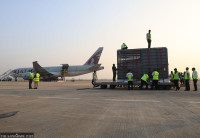Lumbini Province
Several settlements in hill districts of Lumbini at high risk of landslides
Haphazard construction of roads using heavy machinery is also one of the leading causes behind landslides, officials say.
Shamsher Bikram GC
Junga Bahadur Pun, the ward chairman of Gaumukhi Rural Municipality-3 in Pyuthan, has been staying in an animal shed for the past one year. He says he and his family started living in the shed, as his village is at risk of landslides.
“The Khara settlement is gradually sinking. My house’s walls have developed cracks due to landslides. So we have been staying in the cowshed,” Pun said. “Many houses in my settlement are tilted with cracks now.”
According to him, 13 families in the settlement take shelter either in their animal sheds or relatives’ houses every monsoon due to fear of landslides.
The buildings of Khara Secondary School, a local community school, and the ward office of Gaumukhi-3 are also at risk of landslides. A massive landslide erupted just below the settlement last year, displacing Pun and 12 other families.
According to Pun, a team of geologists, with the assistance of the Lumbini Province government, came to Khara to conduct a field study five months ago.
“The geologists studied the landslide-prone settlement but did not give any information to the ward office. I am worried that a landslide will sweep away my settlement,” Pun told the Post.
Not only Khara but several settlements in Gaumukhi Rural Municipality are at risk of water-induced disasters.
The settlements of Paiyupata, Harjakhola, Thulakharka and Lekhchhahara are at high risk of landslides. The local unit said at least 10 houses in Thulakharka should be relocated to safer locations at the earliest due to erosion caused by Jhimruk river.
“Similarly, the households in Lekhchhahara settlement of Gaumukhi Rural Municipality Ward No. 2 also need to be shifted to a safer place,” said Dor Bahadur Rana, the ward chairman of Gaumukhi-2.
Despite the risk of landslides, the relocation process is yet to commence.
“There is no safer place nearby to relocate the settlements and the villagers do not want to leave their ancestral settlements,” said Bishnu Kumar Giri, the chairman of Gaumukhi Rural Municipality.
Of the nine local units in Pyuthan district, Gaumukhi and Naubahini rural municipalities are prone to floods and landslides. As many as 53 people in the area had been killed due to floods and landslides in 2016.
“There are streams flowing below several settlements. The streams erode the banks each year, risking the settlements to landslides,” said Shivaraj Rijal, the chairman of Naubahini Rural Municipality. According to him, residents of Kurtibang, Syaulibang and Khabang settlements of Ligha need to be shifted to safer locations.
Rolpa, another hill district of Lumbini Province, is also affected by landslides every year. According to the District Natural Disaster Management Committee, many settlements in Sunchhahari, Thabang and Tribeni rural municipalities are prone to landslides.
“The villagers cannot sleep well in the rainy season due to fear of landslides. The topography in the area is very fragile. Furthermore, the haphazard construction of roads by using dozers leaves the settlements at high risk of landslides,” said Sher Bahadur Gharti of Seram in Sunchhahari Rural Municipality.
The local people complained that the local unit and other authorities concerned have failed to take concrete steps to control landslides and relocate the villagers to a safe place. No preparations have been made to mitigate the risk of disasters, said Gharti.
“Around 30 percent of settlements in the rural municipality are at risk of water-induced disasters,” said Pabitra Ghartimagar, the vice-chairperson of Sunchhahari. “Some efforts have been made but they are not enough to mitigate the risk of the disaster.”
Gulmi is also one of the districts worst hit by water-induced disasters. Musikot and Resunga municipalities and Satyawati, Malika, Dhurkot, Madane, Chandrakot, Satyawati, Chhatrakot, Ruruchhetra, Kaligandaki, Gulmidarbar and Isma rural municipalities in the district are at high risk of landslides.
“We are formulating an action plan to prevent any untoward incidents in the future. We have kept our team on standby to take necessary actions,” Chief District Officer of Gulmi Rudrawati Sharma.
According to Sharma, the risk of landslides is high in the hills due to their fragile topography. “Haphazard construction of roads using heavy machinery in rural areas is also one of the leading causes behind landslides,” said Sharma.
Road expansion works have increased the risk of landslides in Palpa district as well. Expansion works along the Tansen-Harthok road, Harthok-Chhahara road, Aryabhanjyang-Rampur road and the Siddhartha Highway, among other road sections in Kaligandaki Corridor, have put several settlements at risk of disasters, says Chief District Officer of Palpa Yogendra Prasad Pandeya.
“The settlements in Rampur, Madiphant, Argali, Banstari, Jhadewa, Tinau, Arunkhola, Nisdi and Purbakhola Taar can face possible inundation this monsoon while there’s a threat of landslides in Jalpa, Devinagar, Jhadewa, Madanpokhara, Dovan and Tansen Sammobari,” Pandeya said.
According to the District Disaster Management Committee in Palpa, over 200 families in the district are at risk of landslides and more than 225 families could be displaced due to monsoon-related disasters this year.
Meanwhile, in Arghakhanchi, 24 families displaced by last year’s landslide in Shitaganga Ward No. 12 have yet to return to their settlement, as the risk of landslide is still there and the authorities have failed to relocate them to a safe place.
A massive landslide had erupted at Kothiya Maidan in Shitaganga in September, 2020.
(Kashiram Dangi in Rolpa, Madhav Aryal in Palpa and Birendra KC in Arghakhanchi contributed reporting.)




 11.12°C Kathmandu
11.12°C Kathmandu












%20(1).jpg&w=300&height=200)

